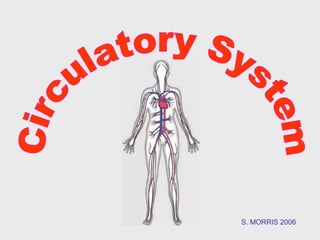
Circulatory system wot
- 2. • Transports oxygen and nutrients. • Carries disease-fighting materials produced by the immune system. • Contains cell fragments and proteins for blood clotting (platelets) • Distributes heat throughout the body to help regulate body temperature.
- 3. How does this system work? pulmonary vein lungs pulmonary artery head & arms aorta main vein Right Left liver digestive system kidneys legs Circulatory System
- 4. Our circulatory system is a double circulatory system. This means it has two parts parts. Lungs the right side of the left side of the system the system deals with deals with deoxygenated oxygenated blood. blood. Body cells
- 5. The Heart This is a vein. It brings These are arteries. blood from the body, They carry blood except the lungs. away from the heart. 2 atria Coronary arteries, the hearts own 2 ventricles blood supply The heart has four chambers now lets look inside the heart
- 6. The Heart Artery to Lungs Artery to Head and Body Vein from Head and Body Vein from Lungs Right Atrium Left Atrium valve valve Right Ventricle Left Ventricle
- 7. How does the Heart work? STEP ONE blood from the blood from body the lungs The heart beat begins when the heart muscles relax and blood flows into the atria.
- 8. How does the Heart work? STEP TWO The atria then contract and the valves open to allow blood into the ventricles.
- 9. How does the Heart work? STEP THREE The valves close to stop blood flowing backwards. The ventricles contract forcing the blood to leave the heart. At the same time, the atria are relaxing and once again filling with blood. The cycle then repeats itself.
- 10. blood from the heart gets around the body through blood vessels There are 3 types of blood vessels a. ARTERY b. VEIN c. CAPILLARY
- 11. The ARTERY Arteries carry blood away from the heart. the elastic fibres allow the artery to stretch under pressure thick muscle and the thick muscle can elastic fibres contract to push the blood along.
- 12. The VEIN Veins carry blood towards from the heart. veins have valves which act to stop the blood from going in the wrong direction. thin muscle and elastic fibres body muscles surround the veins so that when they contract to move the body, they also squeeze the veins and push the blood along the vessel.
- 13. The CAPILLARY Capillaries link Arteries with Veins they exchange materials between the blood and other body cells. the wall of a capillary is only one cell thick The exchange of materials between the blood and the body can only occur through capillaries.
- 14. The CAPILLARY A collection of capillaries is known as a capillary bed. bed artery vein capillaries body cell
- 15. what’s in digested food red blood cells white blood cells oxygen waste (urea) carbon dioxide platelets plasma hormones
- 16. The Blood red blood cell white blood cell platelets plasma
- 17. Red Blood Cells contain haemoglobin, a a biconcave disc that is molecule specially designed round and flat without a to hold oxygen and carry it nucleus to cells that need it. can change shape to an amazing extent, without breaking, as it squeezes single file through the capillaries.
- 18. White Blood Cells there are many different types and all contain a big nucleus. the two main ones are the lymphocytes and the macrophages. macrophages ‘eat’ and digest micro- organisms . some lymphocytes fight disease by making antibodies to destroy invaders by dissolving them. other lymphocytes make antitoxins to break down poisons.
- 19. Platelets Platelets are bits of cell broken off larger cells. Platelets produce tiny fibrinogen fibres to form a net. This net traps other blood cells to form a blood clot.
- 20. Plasma It also contains useful things like; • carbon dioxide A straw- • glucose coloured liquid that • amino acids carries the • proteins cells and the platelets • minerals which help • vitamins blood clot. • hormones • waste materials like urea.
- 21. SUMMARY copy and complete the following; away Arteries take blood ______ from the heart. The walls of an artery are made up of thick _________ walls and elastic fibres. Veins muscular carry blood ________ the heart and also have valves. The towards _________ link arteries and veins, and have a one cell thick wall. capillaries Blood is made up of four main things ______, the liquid part of the plasma blood; Red Blood Cells to carry ______; White Blood cells to protect oxygen the body from disease and _________ help blood clot. platelets
- 22. This powerpoint was kindly donated to www.worldofteaching.com http://www.worldofteaching.com is home to over a thousand powerpoints submitted by teachers. This is a completely free site and requires no registration. Please visit and I hope it will help in your teaching.
